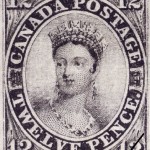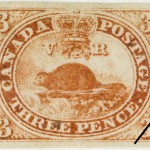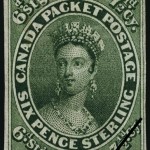From the time that the first Canadian postage stamp was issued in 1851, the adhesives have illustrated culturally, socially and politically important moments in national history. These bits of iconography have displayed narratives that run central to life in Canada, including anything from engravings of native beavers to portraits of the royal crowns of England. It follows that leading Canadian artists have expressed a notably high regard for postage, as seen in the commentary of painter and sculptor Charles Comfort. In 1947, Comfort wrote that stamps, “…bring to the recipient, whether at home or abroad, something of the character, the national dignity, the contemporary awareness of the state in which it had its origin.”
Weak cultural value
Canada Post is responsible for continuing to showcase central accomplishments, traditions and key historic events through postage stamps. High-speed communications have changed this task. Along with conventional stamps stuck on paper envelopes are new forms of delivery geared towards advertising, publishing, government and finance. In today’s digital age, postal transformations in each of these industries detract from the cultural value once associated with the mail.
Selection of early Canadian postage stamps
The Canadian advertising mail sector provides some of the most striking examples of this decrease in value. Before most Canadians had access to the Internet, addressed and unaddressed admail offered unmatched opportunities for publicity. Addressed admail was the preferred route for targeting specific individuals who were generally expected to read their mail. Unaddressed admail was also associated with high readership levels, although with less accurate targeting. In all of this, Canada Post had the unique ability to identify clients on mailing routes.
For 30 years, Canadian stamp collector, dealer and exhibitor Ian Kimmerly benefited from admail’s advantages. Between 1984 and 2014, Kimmerly did most of the promotions for his business Ian Kimmerly Stamps through mailed flyers and catalogues, allowing him to zero in on the precise locations of his customers.
“If you can capture your customers home address or office address, that’s more effective than an e-mail or a newspaper advertisement,” says Kimmerly. This point may reflect the niche market of stamp collectors served by Kimmerly, but it is out of step with forces shaping contemporary advertising.
The rise of digital alternatives
For instance, leading financial institutions are cutting back on mailed advertisements. Between 2010 and 2011, Scotiabank reported a significant decrease in its use of paper for marketing from 165 tonnes to 92 tonnes, a 44 per cent plunge in just one year. This is consistent with the bank’s 2008 introduction of an environmental paper policy incorporating digital marketing strategies and electronic brochures.
This environmental movement reflects increased investment in online advertising. Based on 2013 findings released by the Interactive Advertising Bureau of Canada, a not-for-profit trade association, Canadian advertisers spent more on digital marketing than on print, radio or television mediums. Not surprisingly, earnings from online promotions shot up in the same year, with annual virtual advertising revenues reaching $3.5 billion, a 14 per cent hike from 2012.
This surge in earnings mirrors a growing list of innovative and convenient options for online advertising. Sophisticated digital alternatives have overpowered any advantages that admail could have gained through shrinking newspaper and magazine circulation numbers. Using online display alone, advertisers have been able to single out clients based on demographics, location and search history, which resulted in total spending of $1.1 billion in 2014, up from $800 million in 2011.
Advertising on the Internet is also appealing because of its low costs compared to traditional promotions. Market research conducted by ZenithOptimedia in 2013 showed that digital advertising costs roughly $20 per thousand visitors versus $50 per thousand visitors for mailed advertising.
Additionally, ZenithOptimedia predicts that mobile advertising will experience the most rapid growth. As Canadians continue to purchase smartphones with an expanding list of installed applications, admail must contend with the modern appeal of mobile publicity.
The potential to launch cheaper mobile and web-based versions of newspapers and magazines is also attracting the publishing industry, which is swapping physical mail for digital content. In 2014, Canada Post delivered 36 million fewer publications and renewal subscriptions than it did in 2013. This comes of materials readily available on websites, tablets and smartphones, effectively minimizing the need for the delivery of hardcopy publications.
“A lot of people don’t trust digital. They want a hard copy. A bank statement. A Visa statement. An investment statement.” -Robert Campbell
If U.S. media structures are at all indicative of what’s to come for Canadian titles, the publishing industry will continue to expand its virtual channels. During the first half of 2014, American magazines had 11.6 million digital editions, compared with 10.2 million digital editions in the first half of 2013. Even magazines such as Reader’s Digest and O, which are considerably out of touch with younger demographics, have full-scale smartphone and web-enabled issues.
Slashed postal services
Much like the publication sector, federal bodies are also cutting back on the use of postal mail. Despite Canada Post’s ownership by the Government of Canada, it announced in 2012 that paper cheques will be discontinued by 2016. In its place, federal employees will receive direct deposits.
The decision to gradually eliminate mailed cheques is at odds with a number of Canadians who are skeptical of online banking. Mount Allison University president and vice-chancellor Robert Campbell observed this aversion while chairing the federal panel that authored the 2008 Strategic Review of the Canada Post Corporation.
“A lot of people don’t trust digital. They want a hard copy. A bank statement. A Visa statement. An investment statement,” says Campbell.
From a fiscal standpoint, the desire for physical banking pales in comparison to digital savings. Public Works and Government Services Canada (PWGSC) claims that a single cheque costs $0.82 to produce. By contrast, individual direct deposits cost $0.13. PWGSC anticipates that this difference will save the Government of Canada approximately $17 million annually.
The loss of business from the federal government, which will terminate the distribution of 300 million cheques on yearly basis, is compounded by the Canada Revenue Agency’s (CRA) 2013 decision to no longer mail income tax packages. Not only did the CRA determine that paper costs four times more than electronic packages, in 2011 it found that about one million mailed envelopes went unused. Instead, taxpayers filed electronically.
Bill payments, invoicing and documents sent to customers are also becoming less prevalent. Major companies such as Bell Media, Rogers and TELUS are charging monthly fees for paper statements, causing most new telecom clients to choose online billing. In general, Canadians have taken to electronic payment more quickly than their American counterparts. This includes telephone and web banking.
Client dissatisfaction
Labour unrest at Canada Post has also contributed to e-payment growth. During Canada Post’s two-week lockout in 2011, Becky Stone, co-owner of the Organic Quilt Company in Hudson, Quebec, became particularly disillusioned with the Crown corporation. To accommodate her American clientele, Stone traveled to a U.S. postal service outlet where she dropped off more than 30 packages.
“There is no guarantee that it’s going to get into the mailbox. The postal person can get the addresses mixed up, that happened before…we’re going to push for e-mails.” -Claudette Frappier
“Business was interrupted as a result of the union action and that was incredibly frustrating as a small business owner. That notion rankles a lot of small business owners who have to rely on the postal system,” says Stone.

Organic Quilty Company co-owner Becky Stone. [Photo courtesy of Becky Stone]
The Conference Board of Canada found that most business owners and customers who switched to electronic modes of delivery during the last postal strike have yet to return to Canada Post.
Propane Levac Inc. is another example of a small business turning away from Canada Post. Claudette Frappier is the accounting clerk for the Quebec-based gas company. She mails most statements and invoices to around 19,000 customers, but she is becoming increasingly frustrated with Canada Post’s performance.
“There is no guarantee that it’s going to get into the mailbox. The postal person can get the addresses mixed up, that happened before…we’re going to push for e-mails,” says Frappier.
So far, Propane Levac Inc. has even tried to entice customers to use e-billing through prize draws offering free barbeques and up to $1,000 worth of propane for those who sign up for online payment.
Given public disenchantment and plummeting postal mail volumes, Canada Post’s responsibility to provide delivery for every address in the country is less and less viable. As Canadians press ahead with digital advertising, publishing and payments, the national postal service is no longer as vital as it once was. The proverbial cheque is truly no longer in the mail, nor will it arrive with a stamp of much cultural consequence.








